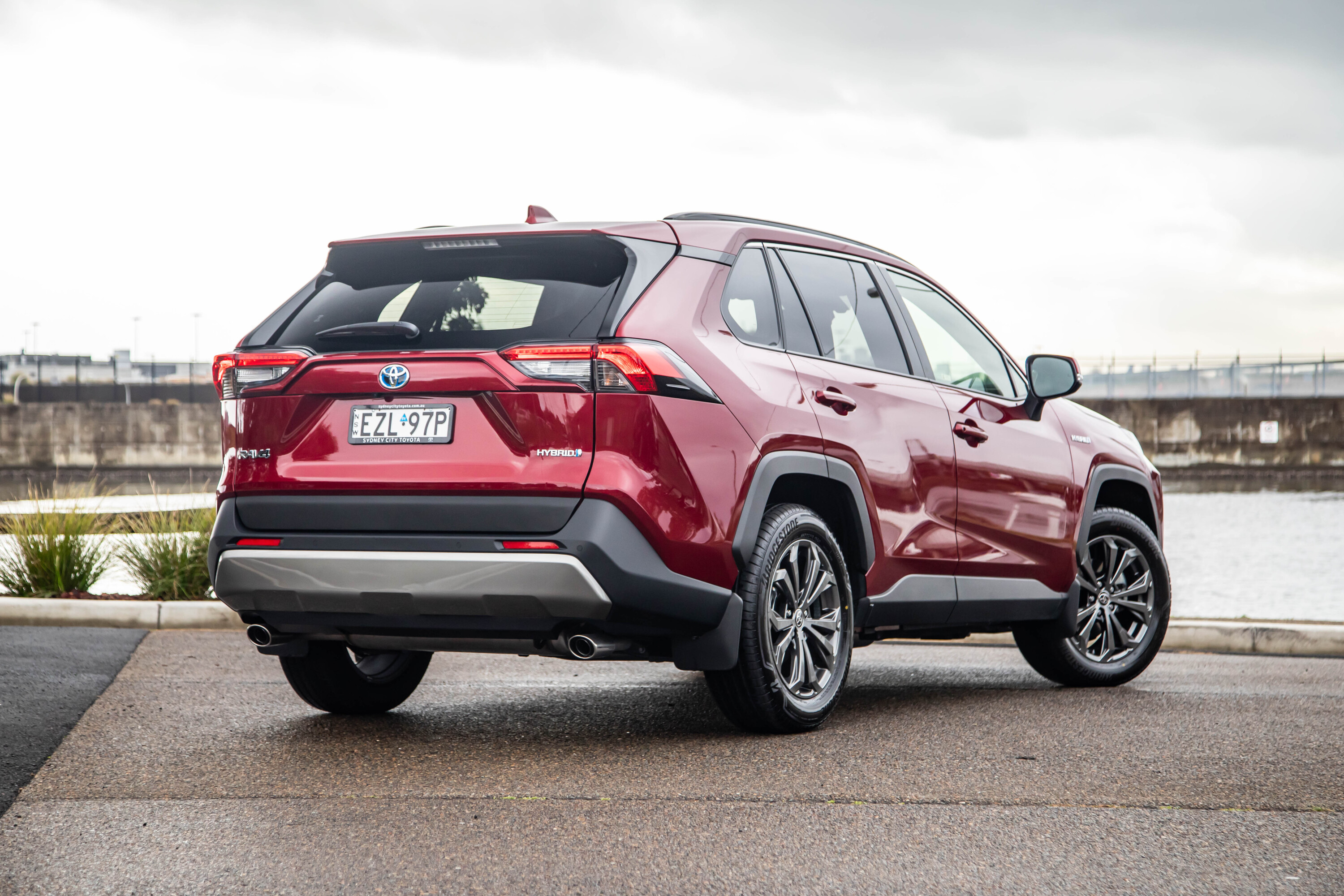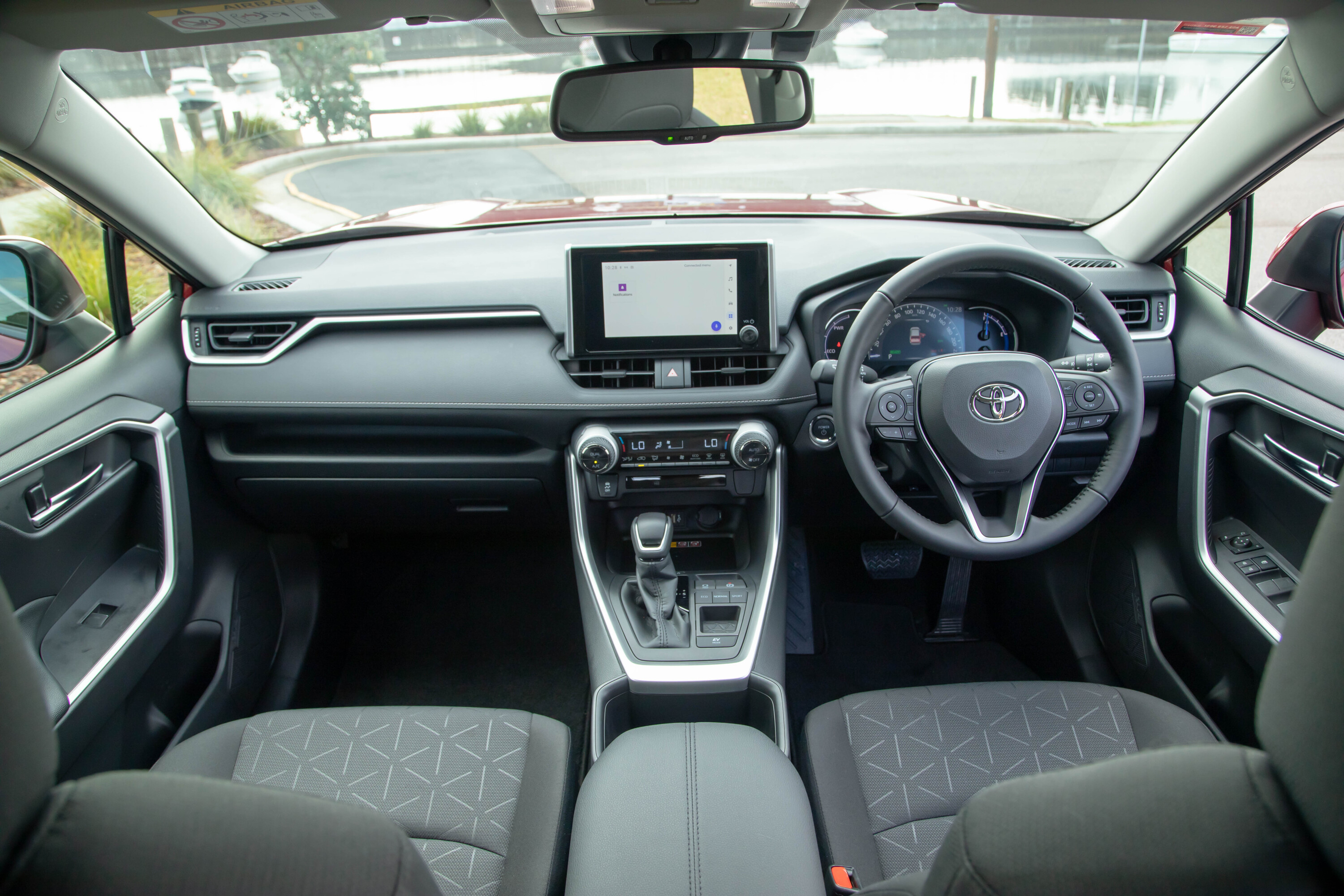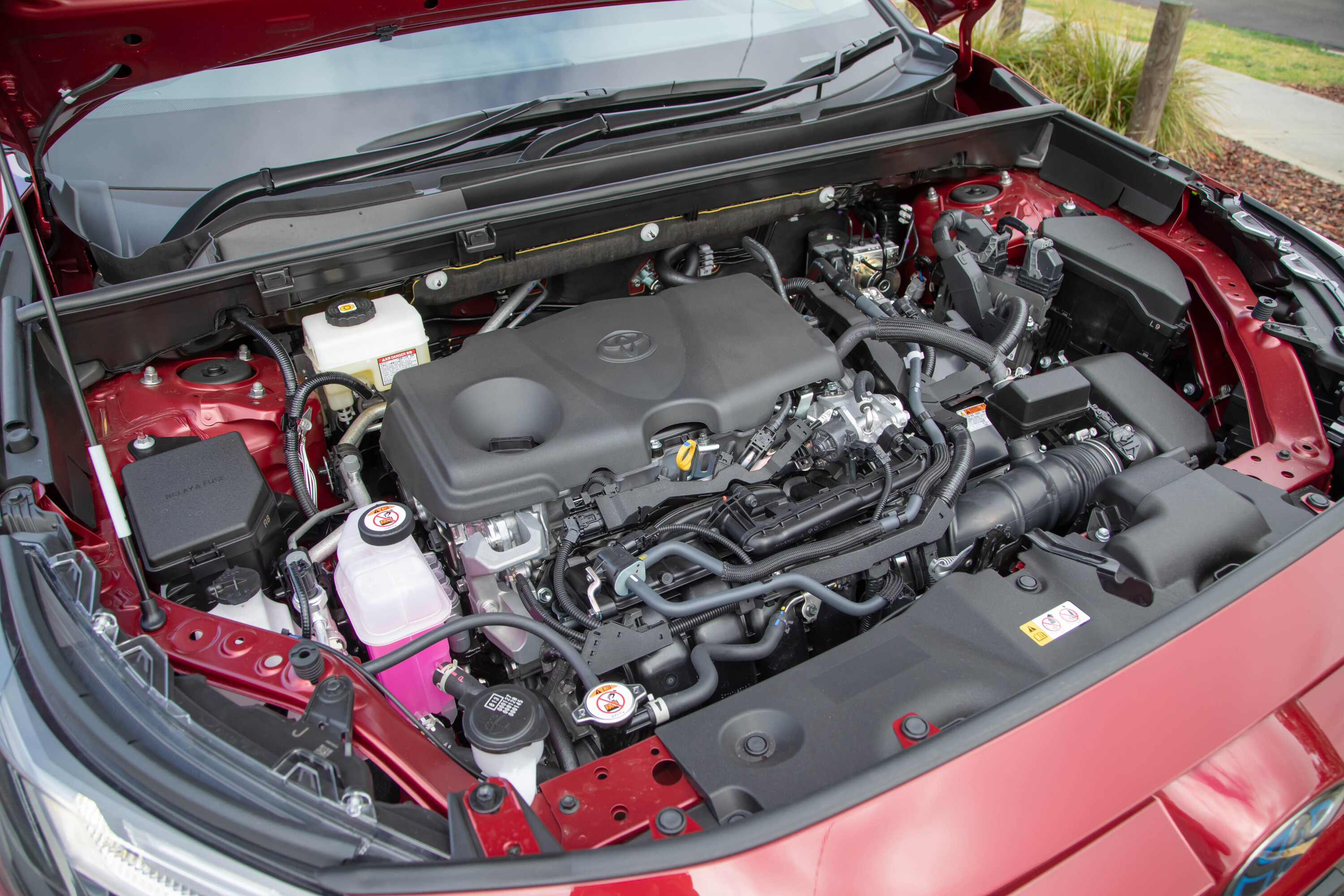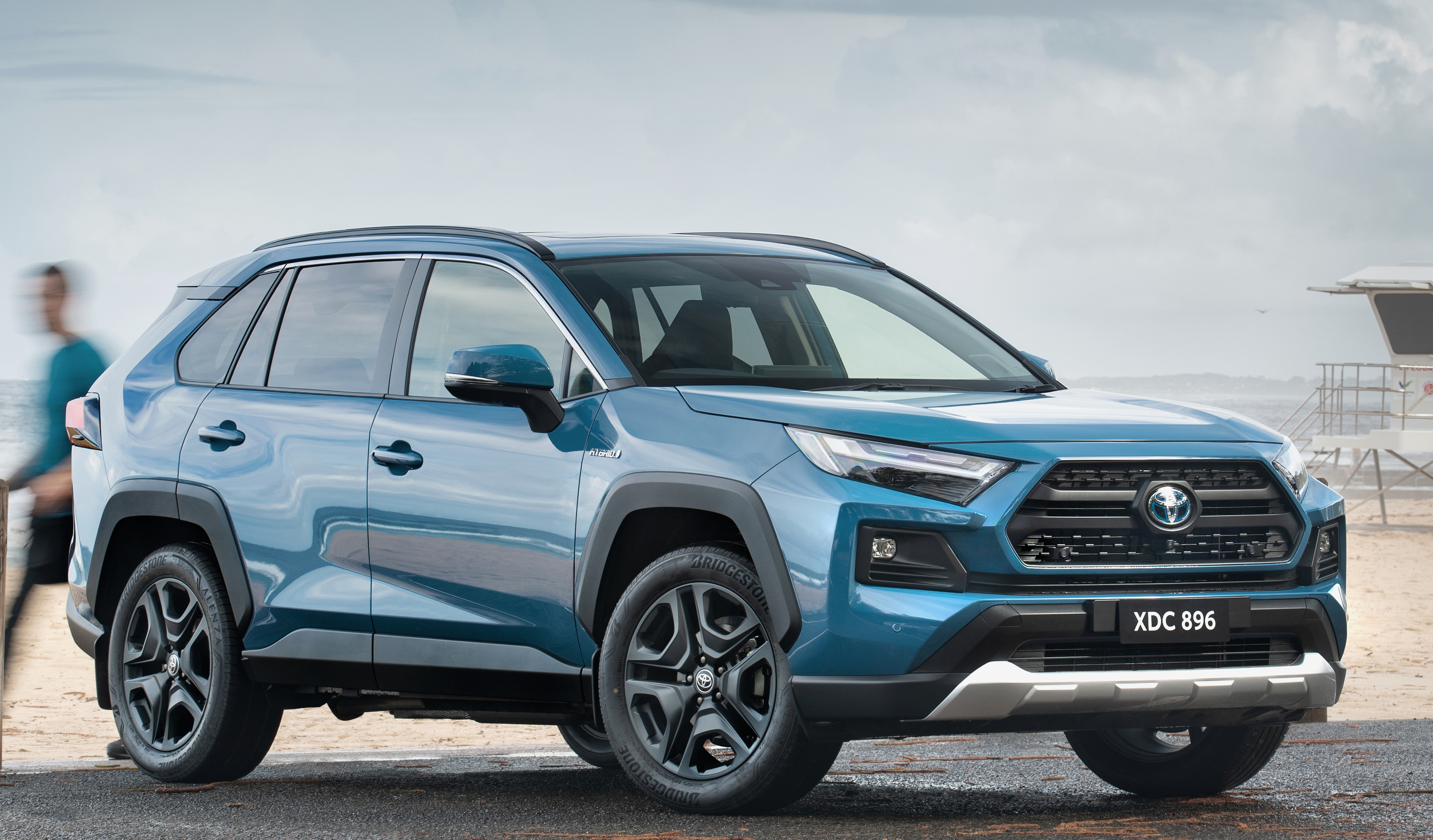
Score breakdown
Things we like
- Hybrid powertrain
- Fun to drive
- Roomy interior
Not so much
- So-so digital dash
- Tiny touchscreen
- Long wait times
- Hefty price rise
Ignoring for the moment the idea that if you ordered a 2022 model year RAV4 you’ll be lucky to get an MY23 given the long wait times, the RAV4 you see in Toyota showrooms today are most definitely MY23s.
The competition is throwing everything at the RAV4, which blends hybrid efficiency with a tough, roomy interior. That means that dollar-for-dollar, other cars in the class may have more gear, better tech or a more comprehensive safety rating.
So for this most recent model year, Toyota tweaked the spec to deliver more stuff, a badly-needed new media system and a little more sizzle on the Toyota Connected Services app front.

JUMP AHEAD
- How much is it, and what do you get?
- How do rivals compare on value?
- Interior comfort, space and storage
- What is it like to drive?
- How is it on fuel?
- How safe is it?
- Warranty and running costs
- VERDICT
- Specifications
How much is it, and what do you get?
As ever, there is a choice of three GXLs, ranging from $40,100 for the front-wheel drive petrol through to $45,600 for the all-wheel drive hybrid. Piggy in the middle, the hybrid front-wheel drive car tested here, retails at $42,600 (all before on-road costs). It’s an easy value equation; this is the one to have.
| 2023 Toyota RAV4 GXL FWD standard features | |
|---|---|
| 7.0-inch semi-digital instrument cluster | 18-inch alloy wheels |
| Rain-sensing wipers | Front and rear carpet floor mats |
| Satellite navigation | 8-inch touchscreen media system |
| Five USB ports (4x USB-C, 1x USB-A) | AM/FM/DAB+ digital radio |
| Wireless Apple CarPlay and wired Android Auto | LED headlights (parabolic in petrol; projector in hybrid) |
| Push-button start | Heated, power-folding side mirrors |
| Over-the-air software updates | Dual-zone climate control |
| Cloth upholstery | 60:40 split-fold rear seats and centre armrest |
| Toyota Connected Services | LED interior lighting |
| Leather-wrapped steering wheel | LED fog lights and daytime running lights |
| Keyless entry and push-button start | Auto-dimming rear-view mirror |
| Privacy glass | Roof rails |
| Wireless phone charger | Dual-zone climate control |
| Leather-wrapped gear shifter | Illuminated door switches |

The touchscreen looks a little ridiculous in the housing that also fits the larger screen of up-spec variants but the upside of that is a proper volume control dial with the signature rubberised texture.
Regardless of screen size, the new media system is a vast improvement and you can have your Apple CarPlay wireless and your Android Auto wired. It’s much fresher and features Toyota Connected, although the car we tested wasn’t activated.
Not that it matters; I’ve used it a lot in Corolla Cross and it’s pretty good but if you’ve got a phone with Siri or Google Assistant or Bixby, it can do most of what you want without having to pay a Disney Plus worth of money every month after the first year. I’ll be interested to see the subscription renewal rate if it ever happens.
The MY23 update did see a hefty price increase of $2150 and, inflation notwithstanding, it’s not obvious where it’s all gone.

How do rivals compare on value?
The main thing to remember is that there are very few other hybrids in this class and they’re all way more expensive than the GXL, making comparisons a bit apples and oranges.
Honda’s ZR-V has just arrived and it’s really quite good. At this level, you’ll score a VTi-L, which at $43,200 drive-away is the middle of three specs and not a hybrid (that’s an option exclusive to the top-spec LX). While quite a bit smaller, it’s not remarkably less accommodating for passengers, with most of the space lost in the cargo area. The interior is clean and functional and very likable.
Hyundai’s Tucson Elite looks like a spaceship and for $43,900 plus on-road costs you can have a turbo-petrol all-wheel drive machine (a hybrid is coming next year). It has a great interior with better technology in the cabin compared to the Japanese pair.

The Tucson’s driveline isn’t as convincing and won’t use as little fuel (at least half as much again) and the service pricing is a bit stiff by comparison. It’s also smaller.
Much of what I say about the Tucson can be applied to the Kia Sportage (including the arrival of a hybrid in 2024). For $43,850 before on-road costs, you can have the SX+ AWD petrol turbo which, again, looks great and has a better interior.
The Kia has a longer total vehicle warranty than the Toyota and Honda but shorter service intervals (10,000km, ditto for the Hyundai) and you will wait a while for one, though not as long as the RAV4.

Interior comfort, space and storage
This generation of RAV4 has been around for a few years now but not much has changed in the cabin.
All the good stuff remains the same. I really like the front seats; they’re comfortable and covered in hardy fabric that should last pretty well even if you give the car a bit of a hammering.
It’s a good cabin design but starting to feel a little old and, in the GXL, looks it with the smaller touchscreen floating in a big bezel. The new-to-GXL digital dashboard is a bit boring but does the job, although my wife complained that the virtual needle in the speedo was too thick, making it difficult to read your speed. I thought it was Luke’s light sabre sweeping slowly across the dash, but conceded her point after the inevitable and deserved look of pity.

You get two cup holders, a spot for your phone under the climate controls, a slot for bits and pieces in the passenger side dash and bottle holders in the doors.
In the back is a very comfortable space for two adults, less so for three regardless of size. The transmission tunnel is a bit chunky for anyone whose feet will reach the ground.
As in the front, there are two cup holders, this time in the armrest, air vents, two USB-C ports (replacing USB-A) and bottle holders in the doors.
You can get up to 580 litres of stuff into the boot but there is some width-restricting wheelarch intrusion. With the 60:40 split seats folded away you’ll have 1690 litres available. Towing is up to 1500kg with a braked trailer.

What is it like to drive?
Although Toyota hasn’t always paid the kind of attention to the way the RAV4 rides and handles many of us would hope it would, this generation was great straight out of the box.
From a standstill, the small battery is enough to get the RAV4 underway and, if you’re light enough on the throttle, all the way up to 30km/h. It’s a fun game in heavy traffic and keeps you paying attention.
The controls all feel good in this car. From the satisfying action of the gear selector through the light and accurate steering to the nicely tuned transition between regenerative and physical braking. The latter even seems to have improved since 2019.

For all of its green credentials, though, the RAV4 gets along smartly and if you can ignore the incessant drone of the engine being held at high revs by the continuously variable transmission (CVT), it feels like a bit of fun.
| 2023 Toyota RAV4 GXL FWD drivetrain | |
|---|---|
| Engine | 2.5-litre four-cylinder petrol-electric hybrid |
| Transmission | continuously vartiable |
| Power (ICE) | 131kW @ 5700rpm |
| Torque | 221Nm @ 3600-5200rpm |
| Power (combined) | 160kW @ 5700rpm |
Toyota still refuses to put a combined torque figure on its hybrid drivelines and while that’s infuriating, it’s a figure you’re unlikely to encounter for very long as the battery drains.

Still, the hybrid system is strong in the mid-range, providing reasonable acceleration while also delivering impressive fuel economy.
What’s most impressive about the RAV4 is its super-plush ride. The segment is overflowing with talent but few can manage the fluidity over Barry White smooth or Axl Rose craggy surfaces. The lower-spec RAV4s are better with the boofier tyres on smaller wheels, but it takes a real belting to catch out the suspension tune.
The impressive ride doesn’t result in an understeery mess, an accusation that can be levelled precious few Toyotas in 2023 as the range moves to more modern architectures. Akio Toyoda’s reign may not have banished boring from the range, but it vastly improved the way the cars drive.
If any of the terms in this section have left you scratching your head, these articles will help bring you up to speed!

- What is a Powertrain or Drivetrain?
- Power vs torque
- Car suspension explained
- Automatic transmissions (‘gearboxes’) explained
- Chassis control systems explained
- Car vs Ute vs SUV: How the vehicle you buy should guide the way you drive
Toyota’s official fuel figure for the RAV4 is 4.7L/100km, which is honestly achievable.
Our RAV4 GXL test car was still quite low kilometres so wasn’t as frugal as the last few hybrid examples we’ve driven, the last one delivering 5.4L/100km.
| 2023 Toyota RAV4 GXL FWD fuel economy | |
|---|---|
| Fuel economy (claimed) | 4.7L/100km |
| Fuel economy (trip computer) | 6.4L/100km |
| Fuel economy (at the pump) | 6.4L/100km |
| Real world range | 859km |
| Fuel type | Standard unleaded |
| Fuel tank capacity | 55 litres |
The RAV4 hybrids happily slurp 91 RON unleaded, too, which is a bonus.

How safe is it?
The RAV4 scored five ANCAP stars in 2019 but if the test were done again today, it might not repeat that feat.
While things have been updated, the MY23 RAV4 does not feature a centre-front airbag like the Corolla Cross or, looking further afield, the Honda ZR-V.
| 2023 Toyota RAV4 GXL FWD safety features | |
|---|---|
| Seven airbags | Autonomous emergency braking (vehicle, pedestrian, cyclist, junction) |
| Lane-keep assist | Adaptive cruise control |
| Lane departure warning | Traffic sign recognition |
| Blind-spot monitoring | Front and rear parking sensors |
| Rear cross-traffic alert | Rear seat belt reminder |

The airbag count includes one for the driver’s knees, however.
You have to go all the way to the top-spec Edge for reverse auto emergency braking (AEB), which feels a bit rude, especially as that feature isn’t even offered as an option lower down. More Mazda CX-5s have this feature but Hyundai’s Tucson is also restricted to the top of the range, so it’s hardly an outlier.
The forward AEB picks up turn assist for MY23 to help stop you turning into oncoming traffic and emergency steering assist is also now standard across the range.
For the kids, you get two ISOFIX points and three top-tether restraints.

Warranty and running costs
Toyota’s five-year warranty applies to the RAV4, with unlimited kilometres into the bargain.
If you service with Toyota, you get a further two years of coverage for the drivetrain.
As ever, you’d be nuts not to because it’s cheap – $260 per interval every 12 months or 15,000km for the first five services. While it’s not as cheap as when this car launched, it still knocks all but the ZR-V out of the park.

VERDICT
This particular version of the GXL is the one to have. The all-wheel drive version only makes sense if you need the extra traction and the non-hybrid is underwhelming at best.
While the RAV4 remains high on my mid-size SUV list, it’s slipping despite the MY23 upgrade. Setting aside the insane waiting times, it’s falling behind on tech and the hide to charge you for things your phone can do seems a little cheeky.
It is, however, dirt cheap to run and in GXL spec, has this part of the market cornered with a hybrid drivetrain that remains firmly at the top of the tree for power and efficiency.
| 2023 Toyota RAV4 GXL FWD specfications | |
|---|---|
| Body | 5-door, 5-seat medium SUV |
| Drive | front-wheel |
| Engine | 2.5-litre four-cylinder petrol-electric hybrid |
| Transmission | continuously vartiable |
| Power (ICE) | 131kW @ 5700rpm |
| Torque | 221Nm @ 3600-5200rpm |
| Power (combined) | 160kW @ 5700rpm |
| Bore stroke (mm) | 87.5 x 103.4 |
| Compression ratio | 14.0 : 1.0 |
| 0-100km/h | 10 sec (estimate) |
| Fuel consumption | 4.7L/100km (combined) |
| Weight | 1675kg |
| Suspension | MacPherson struts front/multi-link rear |
| L/W/H | 4600mm/1855mm/1685mm |
| Wheelbase | 2906mm |
| Brakes | Ventilated disc front / Solid disc rear |
| Tyres | 225/60 R18 |
| Wheels | 18-inch alloy (space-saver spare) |
| Price | $42,600 + on-road costs |
Score breakdown
Things we like
- Hybrid powertrain
- Fun to drive
- Roomy interior
Not so much
- So-so digital dash
- Tiny touchscreen
- Long wait times
- Hefty price rise
We recommend
-
 News
News2023 Toyota RAV4 pricing and features
The updated Toyota RAV4 medium SUV has arrived in Australia with new technology and improved specification – but with price rises of up to $2820
-
 Reviews
Reviews2024 Toyota RAV4 review: Full range detailed
The Toyota RAV4 is regularly the most popular medium SUV in Australia, and with good reason – it sips fuel and drives excellently.
-
 News
News2025 New Car Calendar: All the new cars coming to Australia
Take a look at our list of what is expected to launch in Australia in 2025 – plus those we might not see locally just yet




